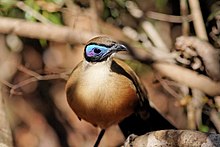Giant coua
| Giant coua | |
|---|---|
 |
|
| Scientific classification | |
| Kingdom: | Animalia |
| Phylum: | Chordata |
| Class: | Aves |
| Order: | Cuculiformes |
| Family: | Cuculidae |
| Genus: | Coua |
| Species: | C. gigas |
| Binomial name | |
|
Coua gigas (Boddaert, 1783) |
|
 |
|
| General Range of giant coua in Madagascar | |
The giant coua (Coua gigas) is a bird species from the coua genus in the cuckoo family that is endemic to the dry forests of western and southern Madagascar. It is suggested that couas probably originated from a particular Asian ground-cuckoo (Dinets 2007). Genus coua contains 10 species, more than any other genus in Madagascar (Moreau 1966). Although the bird is listed under least concern (LC) in the IUCN Red List of Threatened Species, it only persists in the biological hot spot of Madagascar, warranting its recognition as a species of conservation concern at the global scale.
Giant couas are approximately 62 cm in length (nearly double the size of Coua coquereli) and have a blue patch around their eyes, characteristic of the coua genus and similar to African turacos (Chouteau 2006A). As a member of the cuckoo family, they have a reversible third toe and resemble coucals in their method of scrambling through plant tangles for food. Observations indicate that they can climb 10 meters high from the ground(Chouteau 2006A). C. gigas subsist on seeds (Capurodendron madagascariensis and Buxus madagascariensis), insects and some small vertebrates such as chameleons (Furcifer sp.) (Chouteau 2006A). This species of bird is often encountered in large unlogged gallery forests that lack dense shrub layers, which provides greater mobility and implies a preference for undisturbed forest with tall trees (Chouteau 2006A & 2006B; 2004). Studies indicate that in logged forests, giant coua usually glean during dry seasons and more often leap and sally during rainy seasons (Chouteau 2006A). In contrast, they have been found to do the opposite in forested areas (more often glean during rainy seasons and more often probe during dry seasons), which suggests the significant role that environment plays in foraging behavior (Chouteau 2006A; 2006B; 2004). Giant coua tend to utilize microhabitats in logged forests with a greater canopy cover, and forage in logged gallery forests with higher canopies than other areas while avoiding sites with more stems and obstacles (Chouteau 2006A; 2004).
...
Wikipedia

